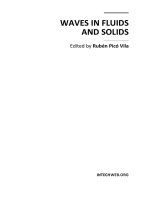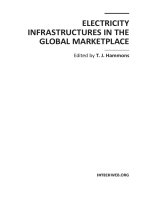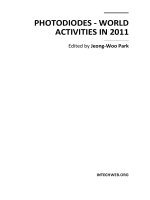Advanced Transmission Techniques in WiMAX Part 1 pot
Bạn đang xem bản rút gọn của tài liệu. Xem và tải ngay bản đầy đủ của tài liệu tại đây (1.9 MB, 25 trang )
ADVANCED TRANSMISSION
TECHNIQUES IN WIMAX
Edited by Roberto C. Hincapie
and Javier E. Sierra
Advanced Transmission Techniques in WiMAX
Edited by Roberto C. Hincapie and Javier E. Sierra
Published by InTech
Janeza Trdine 9, 51000 Rijeka, Croatia
Copyright © 2011 InTech
All chapters are Open Access distributed under the Creative Commons Attribution 3.0
license, which allows users to download, copy and build upon published articles even for
commercial purposes, as long as the author and publisher are properly credited, which
ensures maximum dissemination and a wider impact of our publications. After this work
has been published by InTech, authors have the right to republish it, in whole or part, in
any publication of which they are the author, and to make other personal use of the
work. Any republication, referencing or personal use of the work must explicitly identify
the original source.
As for readers, this license allows users to download, copy and build upon published
chapters even for commercial purposes, as long as the author and publisher are properly
credited, which ensures maximum dissemination and a wider impact of our publications.
Notice
Statements and opinions expressed in the chapters are these of the individual contributors
and not necessarily those of the editors or publisher. No responsibility is accepted for the
accuracy of information contained in the published chapters. The publisher assumes no
responsibility for any damage or injury to persons or property arising out of the use of any
materials, instructions, methods or ideas contained in the book.
Publishing Process Manager Tajana Jevtic
Technical Editor Teodora Smiljanic
Cover Designer InTech Design Team
First published December, 2011
Printed in Croatia
A free online edition of this book is available at www.intechopen.com
Additional hard copies can be obtained from
Advanced Transmission Techniques in WiMAX,
Edited by Roberto C. Hincapie and Javier E. Sierra
p. cm.
978-953-307-965-3
free online editions of InTech
Books and Journals can be found at
www.intechopen.com
Contents
Preface IX
Part 1 Advanced Transmission
Techniques, Antennas and Space-Time Coding 1
Chapter 1 Hexa-Band Multi-Standard Planar
Antenna Design for Wireless Mobile Terminal 3
Yu-Jen Chi and Chien-Wen Chiu
Chapter 2 CPW-Fed Antennas for WiFi and WiMAX 19
Sarawuth Chaimool and Prayoot Akkaraekthalin
Chapter 3 A Reconfigurable Radial Line
Slot Array Antenna for WiMAX Application 49
Mohd Faizal Jamlos
Chapter 4 Reduction of Nonlinear Distortion
in Multi-Antenna WiMAX Systems 59
Peter Drotár, Juraj Gazda, Dušan Kocur and Pavol Galajda
Chapter 5 MicroTCA Compliant WiMAX BS
Split Architecture with MIMO
Capabilities Support Based on OBSAI RP3-01 Interfaces 77
Cristian Anghel and Remus Cacoveanu
Chapter 6 Space-Time Adaptation and
MIMO Standardization Status 103
Ismael Gutiérrez and Faouzi Bader
Part 2 Physical Layer Models and Performance 129
Chapter 7 Hybrid ARQ Utilizing Lower Rate
Retransmission over MIMO Wireless Systems 131
Cheng-Ming Chen and Pang-An Ting
VI Contents
Chapter 8 On Efficiency of ARQ and HARQ
Entities Interaction in WiMAX Networks 147
Zdenek Becvar and Pavel Mach
Chapter 9 Performance Analysis and Noise
Immunity WiMax Radio Channel 165
Oleksii Strelnitskiy, Oleksandr Strelnitskiy, Oleksandra Dudka,
Oleksandr Tsopa and Vladimir Shokalo
Chapter 10 On PAPR Reduction Techniques in Mobile WiMAX 191
Imran Baig and Varun Jeoti
Chapter 11 Peak-to-Average Power Ratio Reduction in
Orthogonal Frequency Division Multiplexing Systems 217
Pooria Varahram and Borhanuddin Mohd Ali
Chapter 12 Design and Implementation
of WiMAX Baseband System 239
Zhuo Sun, Xu Zhu, Rui Chen, Zhuoyi Chen and Mingli Peng
Chapter 13 Performance Evaluation of WiMAX
System Using Different Coding Techniques 265
M. Shokair, A. Ebian, and K. H. Awadalla
Part 3 Mobile WiMAX Techniques
and Interconnection with Other Technologies 295
Chapter 14 Interaction and
Interconnection Between 802.16e & 802.11s 297
Tarek Bchini and Mina Ouabiba
Chapter 15 Inter-Domain Handover in
WiMAX Networks Using Optimized Fast Mobile IPv6 319
Seyyed Masoud Seyyedoshohadaei,
Borhanuddin Mohd Ali and Sabira Khatun
Preface
This book has been prepared to present the state of the art on WiMAX Technology.
The focus of the book is the physical layer, and it collects the contributions of many
important researchers around the world. So many different works on WiMAX show
the great worldwide importance of WiMAX as a wireless broadband access
technology.
This book is intended for readers interested in the transmission process under
WiMAX. All chapters include both theoretical and technical information, which
provides an in-depth review of the most recent advances in the field, for engineers and
researchers, and other readers interested in WiMAX.
In the first section, Advanced Transmission Techniques, readers will find chapters on
modern antennas design for future WiMAX communications and the transmission
enhancements achieved by space-time coding. In the second section, Physical Layer
Models, there are several chapters on the Automatic Repeat Request process and the
common Peak to Average Power Ratio problem for OFDM modulation. Finally, in the
third section the reader will find chapters related to mobile WiMAX problems,
handover processes and interaction with other technologies.
Prof. Roberto C. Hincapie & Prof. Javier E. Sierra
Universidad Pontificia Bolivariana, Medellín,
Colombia
Part 1
Advanced Transmission Techniques,
Antennas and Space-Time Coding
1
Hexa-Band Multi-Standard Planar Antenna
Design for Wireless Mobile Terminal
Yu-Jen Chi
1
and Chien-Wen Chiu
2
1
Department of Electrical Engineering, National Chiao Tung University,
2
Department of Electric Engineering, National Ilan University,
Taiwan
1. Introduction
Electronic devices such as mobile phones and laptop computers are parts of modern life.
Users of portable wireless devices always desire such devices to be of small volume, light
weight, and low cost. Thanks to the rapid advances in very large scale integration (VLSI)
technology, this dream has become a reality in the past two decades. As technology grows
rapidly, a mobile is not just a phone recently. The highly integration of circuits makes the
mobile phone and the PDA (personal digital assistant) been combined into a single handset,
which is called a smart phone. Also, the Internet carries various information resources and
services, such as electronic mail, online chat, file transfer and file sharing, these attractive
proprieties make wireless internet service becomes an important function that should be
integrated into mobile devices. There are many ways for the user to connect to the internet.
The traditional wireless local area network (WLAN) is a popular communication system for
accessing the Internet. However, the reach of WiFi is very limited. WLAN connectivity is
primarily constrained to hotspots, users need to find the access points and can only use it in
certain rooms or areas. As the user get out of range of the hotspot, the signal will become
very weak and the user may lose the connection. This disadvantage limits the mobility of
wireless communication. Except for the widely used wireless local area network, third
generation (3G) mobile telephony based on the High Speed Downlink Packet Access
(HSDPA), which is part of the UMTS standards in 3G communications protocol, is another
high speed wireless internet access service. It has become popular nowadays that people can
get to the internet via cellular communication system. This technology gives the users the
ability to access to the Internet wherever the signal is available from the cellular base station.
However, the quality sometimes depends on the number of users simultaneously connected
per cellular site. In addition to utilizing WLAN/3G dual-mode terminals to enhance
efficiency of mobile number portability service, WiMAX (the Worldwide Interoperability for
Microwave Access) is an emerging telecommunications technology that provides wireless
data transmission in a variety of ways, ranging from point-to-point links to full mobile
cellular-type access. WiMAX is similar to Wi-Fi but it can also permit usage at much greater
distances. The bandwidth and range of WiMAX make it suitable for the applications like
VoIP (Voice over Internet Protocol) or IPTV (Internet Protocol Television). Many people
expect WiMAX to emerge as another technology that may be adopted for handset devices in
the near future.
Advanced Transmission Techniques in WiMAX
4
The rapid progress in mobile communication requires that many functions and wireless
communication systems be integrated into a mobile phone. When portability is taken into
account, antenna that can be built in the phone device is desirable. This has led to a great
demand for designing multiband antennas for handset devices. Among existing built-in or
internal type scheme, the inverted-F (IFA) or planar inverted-F antenna (PIFA) are the most
promising candidates. The linear inverted-F antenna, which is the original version of the
PIFA, has been described by R. King in 1960 as a shunt-driven inverted-L antenna-
transmission line with open-end (king et al., 1960). The PIFA, which is constructed by
replacing the linear radiator element of IFA with a planar radiator element, can also be
evolved from a microstrip antenna. Taga first investigated PIFA’s performance for 800MHz
band portable unit radio in 1987 (Taga & Tsunekawa, 1987). He also wrote a chapter in his
textbook to teach how to design a single band PIFA (Hirasawa & Haneishi, 1922). The PIFA
or IFA are not only small in size but also have a broadband bandwidth. Since it is cheap and
easy to fabricate, it has become very popular with mobile phone manufacturers. Many
references concerning PIFA and its relatives were published in the decade.
In the past decade, researches for variation of the PIFA and multiband antenna grow rapidly
like mushroom. Tri-band, quad-band, penta-band or hexa-band antenna can be found in
many journals (Chiu & Lin, 2002; Guo et al., 2003, 2004; Ciais et al., 2004; Chen, 2007;
Bancroft, 2005; Ali & Hayes, 2000; Soras et al., 2002; Nepa et al., 2005; Wong et al., 2005; Liu
& Gaucher, 2004, 2007; Wang et al., 2007). For example, Chiu presented a tri-band PIFA for
GSM800/DCS1800/PCS1900 in 2002 (Chiu & Lin, 2002) . Using two folded arms between
the two plates, Guo at el. proposed a compact internal quad-band for covering
GSM900/DCS1800/PCS1900 and ISM2450 bands (Guo, et al., 2003). By adding three
quarter-wavelength parasitic elements to create new resonances, Ciais et al. presented a
design of a compact quad-band PIFA for mobile phones (Ciais et al., 2004). In 2004, Guo &
Tan proposed a new compact six-band but complicated internal antenna. His antenna is
comprised of a main plate, a ground plane, a parasitic plate and a folded stub perpendicular
to the two main plates (Guo & Tan, 2004).
In order to integrate all the wireless services into a mobile terminal and have an effective
usage of the precious board space in the mobile device, multiband antenna that is designed
to operate on several bands is necessary. However, designing a multiband antenna in a
narrow space is a great challenge; a method that decrease the complexity of the antenna
structure is also necessary to be investigated. Guo et. al. have recently designed quad-band
antennas for mobile phones (Chiu & Lin, 2002; Nashaat et al., 2005; Karkkainen, 2005) and
dual-band antennas for WLAN operations (Su & Chou, 2008). However, few of these
antennas simultaneously cover the following communication standards: GSM (880-960
MHz), DCS (1710-1880 MHz), PCS (1850-1990 MHz), UMTS2100 (1920-2170 MHz), WLAN +
Bluetooth (2400-2480 MHz), WiMAX (2500-2690 MHz), HiperLAN/2 in Europe (5150-5350 /
5470-5725 MHz) and IEEE 802.11a in the U.S. (5150-5350 / 5725-5825 MHz) (Liu & Gaucher,
2004, 2007; Wang et al., 2007; Rao & Geyi, 2009; Nguyen et al., 2009; Anguera et al., 2010;
Kumar et al., 2010; Liu et al., 2010; Hsieh et al., 2009; Yu & Tarng, 2009; Hong et at., 2008;
Guo et al., 2004; Li et al., 2010). This chapter proposes a planar multiband antenna that
comprises a dual-band inverted-F resonator and two parasitic elements to cover all the
communication standards mentioned above. One element is devoted to generating a dipole
mode and another is helpful to excite a loop mode so as to broaden the impedance
Hexa-Band Multi-Standard Planar Antenna Design for Wireless Mobile Terminal
5
bandwidth. This hepta-band antenna is designed for a mobile device and the parasitic
element broadens the impedance bandwidth to about 45.5%. This antenna is extended to
simultaneously operate in WLAN, WiMAX, and WWAN systems. It covers all cellular
bands world-wide and all wireless network bands, such as the following communication
standards: GSM/DCS/PCS/UMTS/WLAN/WiMAX/HIPERLAN2/IEEE 802.11. The
antenna structure that measures only 50 mm x 12 mm x 0.5 mm can be easily fabricated by
stamping from a metal plate. The following describes the details of the proposed antenna as
well as the experimental results.
Parasitic Element 1
Parasitic
Element 2
Dual Band Main
Resonator
Ground Plane
Feeding Point
Shorting Strip
1
0
0
m
m
5
0
m
m
L
x
y
z
(a)
(b)
Fig. 1. The proposed antenna (a) Three-dimensional configuration of the proposed antenna
(b) Plane view of the antenna structure.
Advanced Transmission Techniques in WiMAX
6
2 Antenna design
2.1 Design of a dual-band antenna
Modern mobile terminals require small and thin design, therefore, planar inverted-F
antenna, which requires a spacing of about 7 mm ~ 12 mm between the antenna and the
substrate to achieve the sufficient operating bandwidth, is not suitable to be integrated with
the present thin mobile terminals although it is popular and widely used. Fig. 1(a) shows a
three dimensional view of the proposed design. The antenna, which is mounted on the top
edge of the printed circuit board (PCB), is fed by a 50 Ω coaxial cable. The antenna is
coplanar with the system ground of the PCB. The dielectric constant of the PCB used here is
4.4 and the thickness is 1.58 mm. As shown in Fig. 1(b), this radiating structure measures 50
mm × 12 mm × 1.5 mm and can be extended to a single metallic plate. It is basically an
inverted-F antenna in which the quarter-wavelength characteristic is obtained thanks to a
short-circuited metallic strip. As indicated in Fig. 1(b), this design comprises a direct-feed
dual band main resonator with two branches (A) and (B), and two parasitic elements (C)
and (D) excited by electromagnetic coupling, to achieve multiband operation.
Shown in Fig. 2 is a typical configuration of an inverted-F antenna. It can be fed by a mini-
coaxial cable which is connected to the RF module. Here, H is the height of the radiator
above the ground plane, L
F
is the horizontal length from the feed point to the open end of
the antenna, and L
B
is the horizontal length from the feed point to the closed end of the
antenna. This antenna is a quarter-wavelength radiator with one short end and one open
end. The resonant frequency can be easily calculated by the formula:
4( )
BF
c
f
HL L
the where c is the speed of light. The resonant frequency can be adjusted by changing the
value L
F
, and the distance L
B
between the feed point and shorting strip can be used to adjust
the input impedance. The height H of the antenna is closely related to the impedance
bandwidth where the Q factor can be reduced by increasing the antenna height to broaden
the bandwidth and vice versa. Variations of IFA Antenna height cause some effects on
bandwidth. Fig. 3 shows the simulation results with different antenna height H. It is found
that increasing the height will increase the impedance bandwidth.
Fig. 2. A typical inverted-F Antenna.
Hexa-Band Multi-Standard Planar Antenna Design for Wireless Mobile Terminal
7
0.5 1 1.5
Frequency (GHz)
-30
-20
-10
0
10
Return Loss (dB)
H = 5mm
H = 6mm
H = 7mm
H = 8mm
H = 9mm
H = 10mm
H
Fig. 3. Antenna height influences on the impedance bandwidth for a simple IFA.
Fig. 4. A variation of typical inverted-F antenna.
Fig. 4 shows another kind of inverted-F antenna while the shorting pin is moved to the
bottom for size reduction. The mechanism of this alternative is the same as the previous one,
but the input impedance is matched by adjusting the length of the shorting strip L
S
.
The dual band inverted-F antenna can be simply accomplished by creating two resonant
paths of the antenna element. As shown in Fig. 5, the dual-band main resonator consists of
two branches (A and B). The length of the longer branch (B) is about 83 mm (9 + 44.5 + 6 +
23.5 mm) which is one-quarter of the wavelength at 900MHz. The lower resonant mode for
GSM operation can be excited on this resonator. On the other hand, branch (A) in the middle
creates a shorter path of 42 mm, which is about a quarter of wavelength at 1800 MHz. As a
result, the resonant mode for DCS operation can be excited. Simulation result of the dual
band antenna is shown in Fig. 6. The input impedance can be adjusted by changing the
Ls
│S
11
│ (dB)
Advanced Transmission Techniques in WiMAX
8
length of the shorting strip L
s
. In this case, L
s
is selected to be 22.5 mm to have the widest
bandwidth at both lower and upper band.
Fig. 5. A dual band inverted-F main resonator.
0.511.52
F
r
equenc
y
(
GHz
)
-25
-20
-15
-10
-5
0
5
Ls = 34.5 mm
Ls = 22.5 mm
Ls = 10.5 mm
Fig. 6. Parameter study with different value of Ls.
2.2 Bandwidth enhanced by a parasitic element
Creating multiple resonant paths of the inverted-F antenna is helpful to generate multiple
resonances. However, the coupling between each resonant path makes it difficult to match
the antenna at each frequency band. To cover the wide bandwidth from 1900 MHz to 2700
MHz, this work introduces a parasitic resonator C near the main driven resonator. This
parasitic element is excited by electromagnetic coupling from the main dual band resonator.
Thus, a dipole-like antenna that resonates at 2250 MHz is formed by both the introduced
│
S
11
│
(dB)
Hexa-Band Multi-Standard Planar Antenna Design for Wireless Mobile Terminal
9
resonator C, and the main resonators A and B. Fig. 7 shows the surface current distributions
on the resonators and the ground plane. Finding show that part of the dual band resonator
and the parasitic element form a dipole antenna. From point a, through point b, c, and d,
then to point f in Fig. 7, the total length (39 mm + 3 mm + 9 mm + 19 mm = 70 mm) is closed
to 0.5 wavelength at 2250MHz (67 mm). This allows the antenna to generate an additional
0.5-wavelength resonant mode at 2250 MHz to cover the desired operation bands.
Fig. 7. Victor surface current distribution at 2.25 GHz.
0.5 1 1.5 2 2.5 3
Frequency (GHz)
-40
-35
-30
-25
-20
-15
-10
-5
0
5
L = 13mm
L = 15mm
L = 17mm
L = 19mm
Fig. 8. Parameter study with different length of the parasitic resonator.
│
S
11
│
(dB)
Advanced Transmission Techniques in WiMAX
10
To demonstrate the effect of the parasitic element covering from 1900 MHz to 2700 MHz,
Fig. 8 shows the parameter study of the proposed antennas with different length of the
parasitic element. By Investigating the Smith chart shown in Fig. 9, it is evident that the
input impedance is closer to 50 Ω as length L increases, because the longer the parasitic
element, the more the loaded capacitance (Chi, 2009). The narrow gap between the main
resonator and the parasitic element C introduces a proper capacitance to compensate for
possible inductance contributed from the dual-band main resonator. Increasing capacitance
neutralizes the effect due to inductance of the strip. Therefore, the capacitive coupled
parasitic element creates a new resonant mode but does not change the original two
resonant modes at 900 MHz and 1800 MHz. The length of the parasitic element is selected to
be 19 mm to have the return loss better than 6 dB in the band of operation. The achieve
bandwidth of the parasitic element is about 34.78 %, covering from 1900 MHz to 2700 MHz,
which is enough for WLAN, WMAN, and WWAN operations.
Fig. 9. Parametric study – Smith Chart.
2.3 Create resonances at the U-NII band
So far, a hexa-band Inverted-F antenna has been designed, except IEEE 802.11a or
HYPERLAN/2. The current research will include the U-NII (Unlicensed National
Information Infrastructure) band in this design by a tuning parasitic resonator D, as Fig. 1(b)
shows. First, the third harmonics of the resonating frequency in the second band (1.72 GHz)
is about 5.20 GHz. This mode which contributes to the U-NII band is also excited. The
surface current distribution on the resonator A in Fig. 10(a) demonstrates that the 1.5
wavelength mode generates at the resonating frequency. The vector current distribution is
shown in Fig. 11(a). Second, the loop resonator E in Fig. 1(b) is designed as a one-
wavelength rectangular loop antenna. The perimeter of the loop antenna (25.5 mm + 1 mm +
Hexa-Band Multi-Standard Planar Antenna Design for Wireless Mobile Terminal
11
25.5 mm + 1 mm) is roughly equal to a wavelength of the resonant frequency 5.59 GHz
(53.67 mm). Fig. 10 (b) shows surface current distributions at the resonating frequency 5.59
GHz, The vector current distribution shown in Fig. 11(b) demonstrates that one-wavelength
loop mode is excited on the resonator E.
(a)
(b)
Fig. 10. Surface current distribution at (a) 5.20 and (b) 5.59 GHz.
Advanced Transmission Techniques in WiMAX
12
(a)
(b)
Fig. 11. Victor current distributions at higher U-NII bands: (a) 5.20 and (b) 5.59 GHz.
Finally, this work applies another technique to tune the higher order resonances for the U-
NII band. The quarter wavelength resonating at 6.0 GHz is only about 12.5 mm. A short
resonator D with a length of 10.5 mm, as Fig. 1(b) shows, is introduced to the short-circuited
pin of the main resonator to form an inverted L-shape parasitic element. The capacitive
coupling between the strip and the chassis increases its electrical length since the radiating
strip is only 1 mm above the ground plane. Adding this parasitic element improves
resonance performance at the U-NII band.
3. Results and discussion
This study constructs and tests the proposed antenna based on the design dimensions
shown in Fig. 1(b). The test structure was shown in Fig. 12 and the measurement of
scattering parameters was performed by an Agilent E5071B network analyzer. Fig. 13 shows
the measured and simulated return loss where the solid red line is the measured result and
the dotted blue line is the simulated one. Findings show good agreement between the
Hexa-Band Multi-Standard Planar Antenna Design for Wireless Mobile Terminal
13
measured data and simulated results. The antenna covers all cellular bands used world-
wide is evident. The achieved bandwidths with return loss better than 6 dB are 80 MHz
(880–960 MHz) in the GSM band, 1000 MHz (1700–2700 MHz) in the
DCS/PCS/UMTS/WiFi /WiMAX band and 1270 MHz (4820–6090 MHz) in the 5 GHz U-
NII band. When ground plane length varies from 80 mm to 120 mm, frequency shifting is
slight (Chi, 2009).
(a) (b)
Fig. 12. Photography of the fabricated antenna (a) top view, (b) side view.
0.5 1.5 2.5 3.5 4.5 5.5 6.5
Frequency (GHz)
-35
-30
-25
-20
-15
-10
-5
0
5
Retu
r
n Loss (dB)
Simulated (HFSS)
Measured
-6dB
Fig. 13. Measured and simulated results of the proposed antenna.
│
S
11
│
(dB)
Advanced Transmission Techniques in WiMAX
14
This study performed radiation-pattern and gain measurement in the anechoic chambers of
SGS Ltd. Taiwan, as shown in Fig. 14. Fig. 15 shows the measured and simulated radiation
patterns at the xy-cut, xz-cut, and yz-cut. The measured radiation patterns show a good
match to the simulation results except at 925MHz. In the small antenna measurement, the
patterns are easily affected by the feeding RF cable in the GSM band (Chen et al., 2005). This
work finds that the dual-polarization radiation-patterns have very suitable characteristics
for portable devices. For the radiation shown in Fig. 14(a), more energy for E
θ
is radiated in
the lower band as compared to Eφ. The Eφ field has some dips at 900 MHz on the xz-plane
or 1800 MHz on the xy-plane. This is probably due to current cancellation on the strips and
the ground plane.
Fig. 14. Radiation Pattern measurement in a 3D anechoic chamber.
Findings also show a dipole-like pattern at the frequency 2170 MHz. Radiation patterns
shown in Fig. 15(b) confirm this deduction. The radiation pattern of this mode is similar to a
small dipole oriented in the y–axis leading to a directional pattern in the E-plane (xy-plane,
blue line) and omni-directional pattern in the H-plane (xz-plane, blue line), as Fig. 15(b),
shows respectively. The resonators C and B at 2170 MHz have strong current distributions
along the z-direction which also contribute to radiation fields. The radiation pattern of this
current distribution is due to a small dipole oriented in the z–axis leading to a bidirectional
pattern in the E-plane (xz-plane, red line) and omni-directional pattern in the H-plane (xy-
plane, red line), as Fig. 15(b), shows respectively. Findings also show an asymmetric
radiation pattern at the U-NII band (5-6 GHz) and some variation and nulls, since different
modes are excited in this U-NII band.
Hexa-Band Multi-Standard Planar Antenna Design for Wireless Mobile Terminal
15
0
90
18
0
270
-35 -25 -15 -5 5
0
90
18
0
270
-35 -25 -15 -5 5
0
90
18
0
270
-35 -25 -15 -5 5
x-y plane x-z plane y-z plane
(a) 925 MHz
0
90
18
0
270
-35 -25 -15 -5 5
0
90
180
270
-35 -25 -15 -5 5
0
90
180
270
-35 -25 -15 -5 5
x-y plane x-z plane y-z plane
(b) 2170 MHz
0
90
18
0
270
-35 -25 -15 -5 5
0
90
18
0
270
-35 -25 -15 -5 5
0
90
180
270
-35 -25 -15 -5 5
x-y plane x-z plane y-z plane
(c) 2650 MHz









